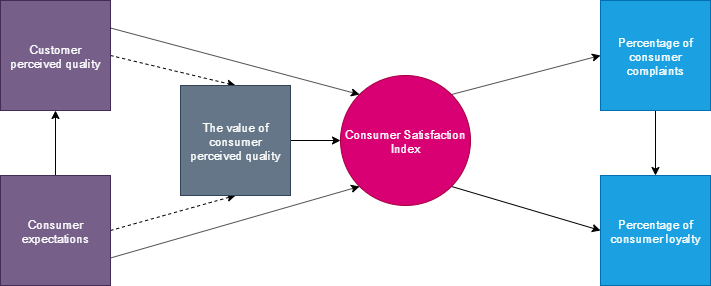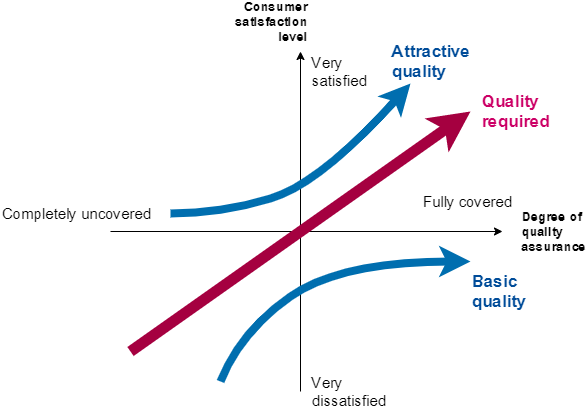Abstract
Attention! At the time of writing this abstract, the master's work is not completed. Estimated completion date – May 2020. The full text of the work and materials on the research can be obtained from the author or his scientific adviser after the specified date.
Содержание
- Introduction
- 1. Theme urgency
- 2. Goal and tasks of the research, expected outcomes
- 3. Overview of research and development
- 3.1 Overview of international sources
- 3.2 Overview of national sources
- 3.3 Overview of local sources
- 4. Customer satisfaction analysis methods
- 5. The company's interaction with customers through the useing advertising products
- Conclusion
- References
Introduction
In modern markets there is a tough competition, which significantly strengthens the role of advertising own products. In this regard, there is necessity to develop an advertising process management strategy.
1. Theme urgency
For each company, which produces high quality unique product at a reasonable price, there is a risk that it will not be in demand among buyers. The way out of this situation is complex advertising, which will help interest a wide range of consumers.
However, any type of advertising has specific disadvantages. Therefore, in order to increase the efficiency of the created advertising products, it is necessary to evaluate the preferences of consumers, to satisfy their needs timely and efficiently. In turn, this will help to retain customers and increase their loyalty to brand. Under the effectiveness of advertising understand a specific result in the form of increased demand for a product of a particular organization or increase its image among competitors.
2. Goal and tasks of the research, expected outcomes
A large number of research related to the study of customer satisfaction indicate the formation of a new area of management related to the study of customer satisfaction and loyalty, which significantly influenced the distribution of relevant programs in companies around the world. However, some aspects are still unexplored. The construction of models and algorithms for analyzing customer satisfaction, which are an integral part of the overall system of company business processes, are among them, as well as the choice of a control limit that determines when a consumer is dissatisfied and this dissatisfaction is caused by non-systemic facts, which should be paid special attention.
The task of this work is to develop such models and algorithms based on the analysis of existing customer satisfaction analysis methods. The implementation of the task is based on using methods and means of computer information technologies.
Orientation of models is aimed at improving algorithms and methods for the provision of advertising services. For their development, it is advisable to use an object-oriented paradigm that solves at a new level the important task of structuring information from the point of view of controllability, which significantly improves controllability of the modeling process itself.[1].
In accordance with the goal, a number of tasks are solved in the work:
- Analysis of modern methods and algorithms of satisfaction research.
- The rationale for the creation of models and algorithms of customer satisfaction research of advertising services.
- Formation of key requirements that must be met by developed models and algorithms.
- Development of models and algorithms for advertising products customer satisfaction research based on an object-oriented paradigm.
- Formation of a methodology for analyzing customer satisfaction indicators based on developed methods.
- Testing the established methodology for analyzing customer satisfaction indicators, evaluating its effectiveness.
The object of research in this case is the advertising market is a place where there is a supply and а demand for advertising services. The advertising market is an independent sector of the economy, within which the subjects of this market interact is advertisers, advertising producers, advertising distributors and consumers. The subject of research in the work is customer of advertising products satisfaction analysis methods and methods of studying the data.
3. Overview of research and development
Today, customer satisfaction research in various fields of activity is being actively developed. It is based on using modern methods of developing models and algorithms, including an object-oriented paradigm.
3.1 Overview of international sources
For a long time, research has been actively conducted in the field of customer satisfaction analysis , which generate new and effective models and methods of its assessing. I would like to highlight some foreign experts on this topic: F. Reicheld [ 2 ], N. Kano [ 3 ], P Farris, N. Bendl, P. Pfeifer, D. Reibshtein [ 4 ], A. Parasuraman, V.A. Zeithaml, L. L. Berry [ 5 ] and others. Today, customer satisfaction assessment has become a mandatory attribute of customer relationship management systems [ 6 ].
3.2 Overview of national sources
The issue of customer satisfaction analysis and assessment did not go unnoticed among Russian scientists. These include G. Polynskaya, in the research she conducts a comparative analysis of methods for assessing customer satisfaction using different methods of data collection
[ 7 ]. I can also highlight S. Turko's research dedicated to customer satisfaction and loyalty monitoring [ 8 ].3.3 Overview of local sources
As a result of students of Donetsk National Technical University works review, it was revealed that some students also dealt with issues related to customer satisfaction:
- I. Sazonov Estimation of consumers satisfaction [9];
- V. Pyatakov Proposals development of consumer satisfaction analysis on public corporation
Donetsk Plant of Mine-Rescue Equipment
[10]; - O. Gordus System of monitoring of loyalty and satisfaction of the consumer[11];
- A. Bezkrovnaya Ways of improving the Class udovletvorennosty consumers to enterprises Liga metyznoy industry [12];
However, the questions customer satisfaction research in the field of advertising services have not been previously covered, although they have a number of significant differences related to the design and advertising products distribution methods.
4. Customer satisfaction analysis methods
Assessment of the level of customer satisfaction has become common practice for companies, which carry out activity in the service industry. Organizations representing the service sector are quite mobile in responding to customer requirements, study the properties of goods, plan services with higher additional perceived value [ 13 ].
Companies regularly conduct surveys to measure customer satisfaction. Among the various assessing satisfaction methods there are some of the most effective:
- Customer satisfaction Index (CSI) is an assessment of customer satisfaction after interacting with a company. CSI reflects how successful customer experience has been.[14].
- The Kano model is used to assess the emotional reaction of consumers to individual product characteristics [15].
- Net Promoter Score (NPSis an indicator that measures the willingness of customers to recommend brand products or services [16].
- A multi-attribute product model of satisfaction is defined as a weighted average assessment of the performance or presence of product properties and their importance to the consumer [17].
- Customer Satisfaction Score (CSAT).

Figure 1 – Customer satisfaction index model

Figure 2 – Model N. Kano

Figure 3 – Promoter net index Concept
The combination and development of these methods will make it possible to build further business processes of the company more effectively, improve the quality of provided services, which will more fully consider the interests of consumers.
5. The company's interaction with customers through the useing advertising products
As customers, the set of consumers of the primary and secondary markets is accepted. The first group represents companies purchasing products for operation or for use in their own production as components; the second group includes companies purchasing products for subsequent sale (dealers, distributors).
Interaction with customers through advertising consists of several connected stages, which include work with potential customers at the stage of their search and attraction, interacting with existing customers of the company and increasing customer loyalty by developing and implementing a loyalty program, and can be represented by the model shown on figure 4.

Figure 4 – Model of interaction with customers through the useing advertising products
(animation: 10 frames, 7 cycles of repeating, 25,3 KB)
An umber of events are carried out at the stage of searching and attracting new consumers:
- databases of potential consumers are created by searching for information in accessible ways;
- mailing of promotional offers containing information about possible cooperation is carried out;
- participation in various industry exhibitions is organized, presentation events in order to promote the enterprise and its products are initiated;
- feedback with potential customers is established on the results of the promotional offers distribution and participation in exhibitions;
Further, the interaction with attracted potential consumers is carried out :
- a detailed research of the attracted audience features is carried out in order to plan an effective advertising company;
- adjustments are made to an existing advertising proposal according to the results of satisfaction survey with existing advertising products;
- as a result of creating the most effective advertising appeal, the process of establishing cooperation begins.
Each company is interested in retaining customers when a customer repeatedly chooses the same supplier in the presence of competition in the market. Therefore, an important step in the model of interaction with consumers is building long-term cooperation, that is creating a loyal customer.
To sum up, it is planned to develop models and algorithms based on an existing consumer satisfaction research analysis methods. The implementation of the task will be based on an object-oriented paradigm. It is also planned a step-by-step implementation of the developed models and algorithms at the enterprise to build a further process for managing the company and finding ways to improve the quality of service, which will take into account the interests of consumers and especially their requirements.
Conclusion
Customer satisfaction analysis is extremely important for any organization related to the provision of services, in particular advertising. Based on the obtained data, it is possible to competently build a development strategy with a step-by-step implementation of the developed models and algorithms for assessing customer satisfaction. The basis of any business should be customer satisfaction, and it should also consider in management decisions. Thus, based on the desires of consumers, the organization will be able to fulfill their requirements to the full and anticipate their expectations, thereby improving the quality of the services provided, which will achieve not only financial success, but also consumer commitment.
References
- Основные понятия объектно-ориентированного подхода [Электронный ресурс]. – Режим доступа: http://citforum.ru/programming/oop_rsis/glava1.shtml.
- The One Number You Need to Grow by Frederick F. Reichheld [Электронный ресурс]. – Режим доступа: https://hbr.org/2003/12/the-one-number-you-need-to-grow.
- Объяснение модели Кано: анализ и примеры [Электронный ресурс]. – Режим доступа: https://lpgenerator.ru/blog/2018/07/03/obyasnenie-modeli-kano-analiz-i-primery/.
- Marketing metrics: the definitive guide to measuring marketing performance / P. Farris, N. Bendle, P. Pfeifer, D. Reibstein. – New Jersey : Pearson Education, 2010.
- Parasuraman, A. SERVQUAL: a multiple-item scale for measuring service quality / A. Parasuraman, V. A. Zeithaml, L. L. Berry // J. of Retailing. – 1988. – No. 64 (1).
- Волкова, А. А. Влияние восприятия цен на восприятие качества / А. А. Волкова // Теория и практика обществ. развития. – 2014. – № 5. – С. 199–201.
- Полынская, Г. А. Сравнение методов оценки удовлетворенности потребителей при использовании разных способов сбора данных / Г. А. Полынская, // Управление экономическими системами. – 2014.
- Турко С.В. Мониторинг удовлетворенности и лояльности потребителей [Электронный ресурс]. – Режим доступа: https://www.dissercat.com/content/monitoring-udovletvorennosti-i-loyalnosti-potrebitelei.
- Сазонов И.В. Оцека удовлетрённости потребителей. [Электронный ресурс]. – Режим доступа: http://masters.donntu.ru/2006/mech/sazonov/diss/index.htm.
- Пятаков В.В. Разработка предложений по анализу удовлетворенности потребителей на ОАО «Донецкий завод горноспасательной аппаратуры. [Электронный ресурс]. – Режим доступа: http://masters.donntu.ru/2008/mech/pyatakov/diss/index.htm.
- Гордус О.И. Мониторинг удовлетворенности и лояльности потребителей. [Электронный ресурс]. – Режим доступа: http://masters.donntu.ru/2010/fknt/gordus/library/article9.htm.
- Безкровная А.И. Пути повышения степени удовлетворенности потребителей на примере предприятий метизной промышленности.[Электронный ресурс]. – Режим доступа: http://masters.donntu.ru/2013/iem/bezkrovnaya/diss/index.htm.
- Рудакова О.Ю. Развитие институциональной модели управления качеством бытовых услуг: автореф. дис. канд. экон. наук: 08.00.05. Шахты, 2012.
- Оценка удовлетворенности и лояльности клиентов. [Электронный ресурс]. – Режим доступа: https://mtp-global.com/customer-satisfaction-index-2/.
- Модель Кано. [Электронный ресурс]. – Режим доступа: http://fdfgroup.ru/poleznaya-informatsiya/stati/model-kano/.
- NPS: «индекс потребительской лояльности», который нужно отслеживать каждой компании. [Электронный ресурс]. – Режим доступа: https://texterra.ru/blog/nps-indeks-potrebitelskoy-loyalnosti-kotoryy-nuzhno-otslezhivat-kazhdoy-kompanii.html.
- Каландаришвили К. Ф., Рудская Е. Н. Формирование экосистемы лояльности клиентов: инновационные инструменты социально-ориентированного маркетинга в банковской сфере // Молодой ученый. – 2015. – №10. – С. 673-685. [Электронный ресурс]. – Режим доступа: https://moluch.ru/archive/90/18844/.
